What Size Rug for a King Bed? The Complete Guide to Getting It Right
How to Choose the Perfect Rug Size to Make Your Bedroom Look Designed, Not Accidental
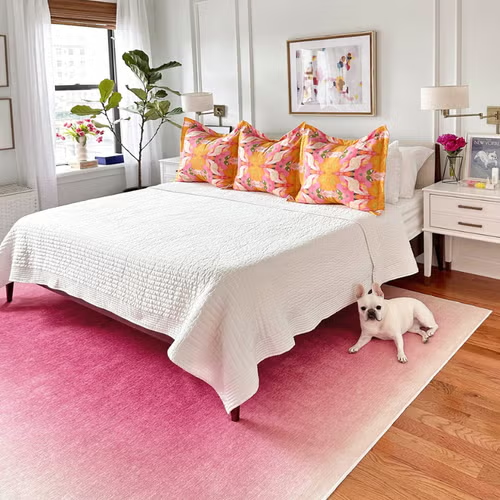
Ever walk into someone's bedroom and feel like something's just... wrong? Nine times out of ten, it's because they've got their king bed sitting on a rug that's way too dinky. The whole room ends up looking like the furniture's just visiting, not actually living there. Your bed–especially a king–needs to feel rooted, substantial. Not like it's balanced on a doormat.
Here's the thing about rug sizing that nobody tells you: it's not about finding something big enough to catch your toes when you roll out of bed. It's about creating this invisible foundation that pulls everything together. Get it wrong, and your entire bedroom feels disjointed. Get it right, and suddenly you've got a space that looks like it belongs in a magazine.
We dug into what actually works to help you buy the right rug for your room, because let's be honest–most of us can't afford to keep buying rugs until we figure it out.
All products and deals are sourced by the Rank & Style team using data and expert insights. If you shop through our links, we may earn a commission—at no extra cost to you.
Best Rug Sizes for King Beds: The Quick Answer
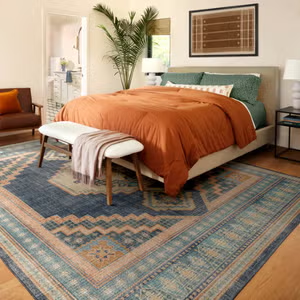
ruggable
If you just want the bottom line: 9x12 feet works for most situations. It's big enough to make your king bed feel anchored without eating up every square inch of floor space. Most bedrooms can handle this size, and it gives you that "expensive bedroom" look without actually requiring an expensive bedroom.
Want to go full luxury? 10x14 feet is your move. This size makes even regular bedrooms feel like master suites. You get tons of soft landing space, and everything looks deliberately chosen rather than squeezed in.
On a tighter budget or dealing with a smaller room? 8x10 feet can work, but you'll need to be clever about where you put it. Done wrong, it looks stingy. Done right, it can actually make a small room feel bigger.
Understanding King Bed Dimensions and Rug Placement
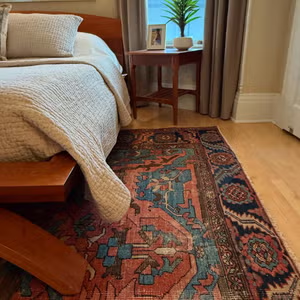
@claire__kayser
Your king bed is roughly 6.3 by 6.7 feet–bigger than most people realize until they're trying to maneuver it up the stairs. But when you're thinking about rugs, you can't just think about the bed itself. You need to consider the whole sleeping zone: nightstands, the space you need to actually get in and out of bed, plus enough visual breathing room so nothing looks cramped.
The old-school rule says 18 to 24 inches of rug extending beyond your bed frame. That's a decent starting point, but real life is messier than rules. Sometimes you've got a weird-shaped room, or a radiator that throws off your placement, or nightstands that are chunkier than average.
Platform beds get away with less rug extension because they're visually lighter. Traditional beds with box springs and big headboards? They need more rug to look balanced. It's like visual weight–heavier furniture needs more foundation. (Image credit: @claire__kayser)
The 4 Most Common Rug Placements for King Beds
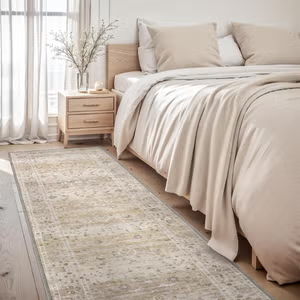
amazon
There are really only four ways to do this that don't look like accidents waiting to happen. Each has its place depending on your room size, budget, and how much visual drama you're going for.
Full Coverage (9x12 or 10x14 rug)
This is the approach that screams "we knew what we were doing." The rug extends way beyond the bed on all sides. Your nightstands sit on it, you get cushy landing space everywhere, and the whole sleeping area feels like one cohesive unit. Perfect for when you want that boutique hotel feeling in your own bedroom.
Partial Coverage (8x10 rug)
This works when you don't have endless space or endless budget. The trick is strategic placement–usually extending about 18 inches past the foot of the bed and splitting the difference on the sides. It's not as luxurious as full coverage, but it still looks intentional if you position it right.
Foot-of-Bed Only (6x9 or 8x10 rug)
Sometimes called the "accent" approach, this puts a smaller rug just at the foot of the bed. It can work in tiny bedrooms or when you're going for a minimalist vibe. The catch? It needs to be wide enough to feel substantial. If it's narrower than your bed, it looks like you grabbed whatever was on sale.
Bedside Runners (2.5x8 or 3x10 runners)
For narrow bedrooms or funky layouts, matching runners on each side can be genius. They give you the comfort underfoot while keeping things clean and uncluttered. Just make sure they're long enough to extend beyond both the headboard and footboard, or they'll look stubby.
How Room Size Affects Your King Bed Rug Choice
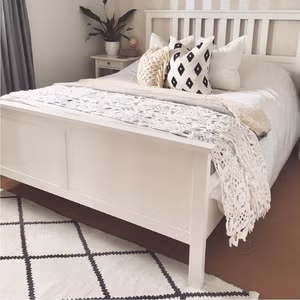
@ourlifemapped
Your room's actual dimensions should drive this decision more than any style preference or Pinterest board. What works in a sprawling master suite will look ridiculous in a cozy 10x12 bedroom.
Small Bedrooms (under 12x14 feet)
Every square foot counts here. An 8x10 rug can work if you position it carefully, but consider runners or foot-of-bed placement instead. Light colors help keep the space from feeling cramped. Dark rugs in small rooms can make everything feel like a cave.
Medium Bedrooms (12x15 feet)
This is where the 9x12 really shines. You've got enough space for proper proportions without the rug taking over completely. Most standard bedroom furniture arrangements work beautifully with this size.
Large Bedrooms (15x18+ feet)
Go big with confidence. A 10x14 rug or even larger creates the right scale in spacious rooms. Anything smaller risks looking lost in all that floor space, like a postage stamp on a billboard.
The biggest mistake? Not measuring your actual room and just eyeballing it. Room dimensions that look similar can have totally different rug needs based on where your windows are, how the doors swing, and what other furniture you're working around. (Image credit: @ourlifemapped)
Common King Bed Rug Mistakes (and How to Avoid Them)
- The "Too Small" Trap: This is the big one. Beautiful bedrooms get completely undermined by rugs that look like oversized placemats next to king beds. If your rug doesn't extend at least 18 inches beyond your bed frame, it's probably too small. When you're wavering between sizes, go bigger.
- Off-Center Disasters: Your rug should be centered on the bed, not the room. Tons of people center it in the floor space and end up with weird proportions where one side has tons of rug and the other side has none. The bed is your anchor point–everything else adjusts around it.
- Nightstand Confusion: Those nightstands need to have a relationship with the rug somehow. Either they're completely on it, completely off it, or positioned so their front legs are on the rug. Random partial coverage looks sloppy and unfinished.
- Door Clearance Problems: Make sure your rug choice doesn't mess with door swings or create tripping hazards. This is especially important for bedroom doors and closet doors that open into the space. Nothing ruins a beautiful bedroom like stubbing your toe every morning.
Best Places to Buy Area Rugs
Finding the right rug in the right size doesn't have to mean driving to twelve different stores or scrolling through hundreds of websites.
Here's where to look for quality options that won't break the bank:
- Home Depot might not be your first thought for bedroom rugs, but they've seriously stepped up their home decor game. Great for budget-friendly options and they often have larger sizes in stock. Check for Home Depot coupons before you buy, and they run sales pretty regularly.
- Wayfair is basically the Amazon of home goods, with tons of size options and customer photos that show rugs in real bedrooms. Their return policy is solid, which matters when you're buying something this big online. Look for Wayfair promo codes for the best deal.
- Ruggable has revolutionized the rug game with washable options that are perfect for bedrooms. Their sizes work well for king beds, and being able to throw your rug in the washing machine is a game-changer. For an extra discount, grab a Ruggable coupon.
- Target offers surprisingly good quality for the price, especially their Project 62 and Opalhouse lines. Limited size selection, but what they have tends to be well-made and on-trend. Check for Target coupons in our deals section or in their app for extra savings.
- Amazon has everything, including some great vintage-style rugs and budget options. Just stick to highly-rated sellers and read the reviews carefully–rug quality can be hit or miss. Amazon promo codes pop up frequently, especially during Prime events.
- Bed Bath & Beyond is making a comeback with stylish, affordable area rugs and frequent sales. Their home section includes classic and contemporary styles in bedroom-friendly sizes. Be sure to check for a Bed Bath & Beyond promo code before you checkout to score even more savings.
- West Elm and CB2 offer more design-forward options if you want something unique.
- Nordstrom carries higher-end rugs with their excellent return policy–look for Nordstrom coupons or shop during their anniversary sale.
- For luxury options, Saks Fifth Avenue has beautiful designer rugs, though expect to pay accordingly. Saks Fifth Avenue promo codes can make these more accessible.
Budget-Friendly Alternatives That Don't Look Cheap
You don't need to drain your savings account for a massive rug. Strategic placement of smaller rugs can work beautifully–coordinating runners on each side of the bed, or a well-positioned 8x10 at the foot. The secret is making it look deliberate rather than like you ran out of money halfway through decorating.
Layering can work wonders too. A larger, inexpensive neutral rug as a base with a smaller, more interesting rug on top creates visual interest while keeping costs reasonable. Vintage and secondhand rugs often come in perfect bedroom sizes at a fraction of retail prices.
Don't overlook DIY solutions either. Large remnants can be bound to custom sizes, giving you designer proportions without designer prices. Some carpet stores will do this for surprisingly little money.
Special Considerations for Different Bedroom Layouts
Not all bedrooms are perfectly rectangular with the bed centered on one wall. Real homes have weird angles, multiple functions, and architectural quirks that throw off the standard playbook.
Master Bedrooms with Sitting Areas
You might need two rugs–one for the sleeping area and another to define the seating space. They should coordinate but don't necessarily have to match exactly. Think of them as related, not identical.
Awkward Room Shapes
L-shaped or very long, narrow bedrooms need creative solutions. Sometimes multiple smaller rugs work better than trying to force one large rug into an odd space. Work with your room's quirks instead of fighting them.
Rental Properties
Focus on removable options that make a big impact without permanent changes. Choose rugs that can work in multiple spaces as you move from place to place.
Making Your Rug Choice Look Intentional
The difference between a room that looks professionally designed and one that looks like a furniture showroom floor is often in the details. Your rug should feel connected to the rest of your bedroom's color palette and style. It doesn't have to match perfectly, but it should relate somehow.
Think about sight lines too. What do you see when you first walk into the room? What about from the bed? The rug should enhance these views, not compete with them for attention.
Texture adds visual interest without overwhelming smaller spaces. A subtle pattern or varied pile height can make a simple rug feel more expensive and intentional. Sometimes it's the small details that make the biggest difference.
Frequently Asked Questions
Can I use a round rug with a king bed?
Round rugs can work, but they need to be quite large–at least 10 feet in diameter–to provide adequate coverage. They work best in rooms with curved architectural elements or when you want to soften all the angular furniture.
What if my room is too small for a 9x12 rug?
Focus on strategic placement of smaller rugs. Runners on each side of the bed or a well-positioned 8x10 at the foot can work beautifully in compact spaces. Sometimes less is actually more.
Should the rug go under the nightstands?
Ideally, yes. Having the front legs of nightstands on the rug creates cohesion. If that's not possible, having them completely off the rug works better than partial coverage, which just looks indecisive.
How do I know if my rug is too small?
If it looks like a bath mat next to your king bed, it's too small. The rug should extend at least 18 inches beyond the bed frame where possible, and feel substantial enough to anchor the sleeping area rather than just decorating it.
The Bottom Line
Choosing the right rug size for your king bed is about creating a cohesive, comfortable space that feels intentional. Most people can't go wrong with a 9x12 rug, but understanding your specific room and needs helps you make the best choice for your space and budget. Trust the process, measure twice, and don't be afraid to go bigger than your first instinct suggests–you'll probably be glad you did.
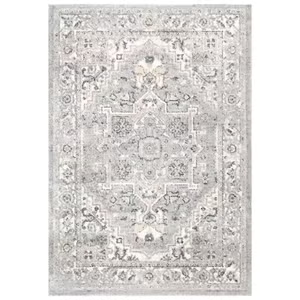
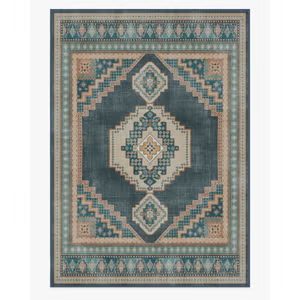
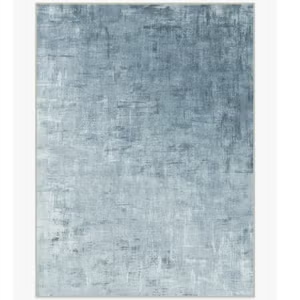
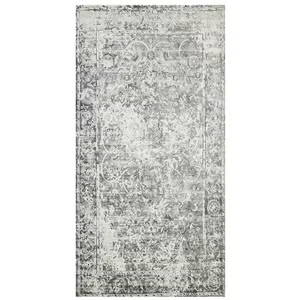
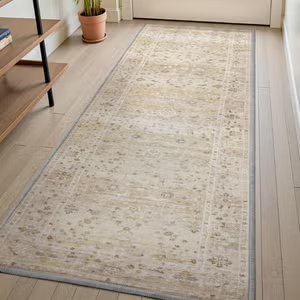
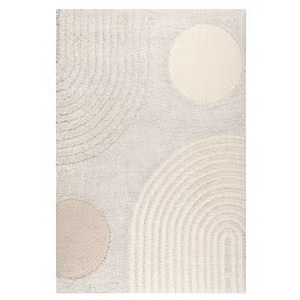
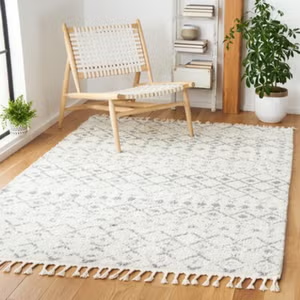
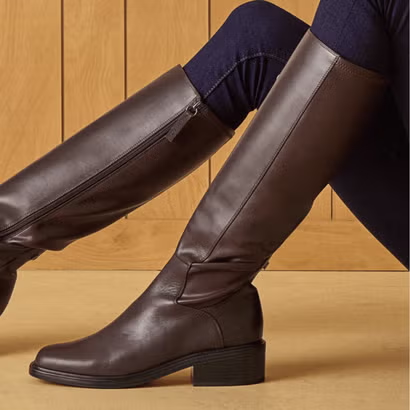


.png?width=410)



